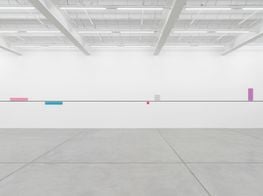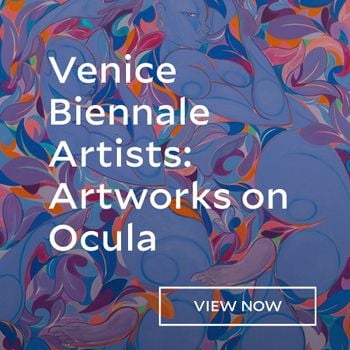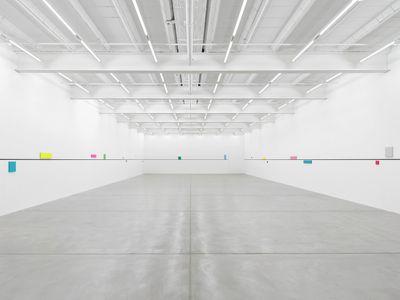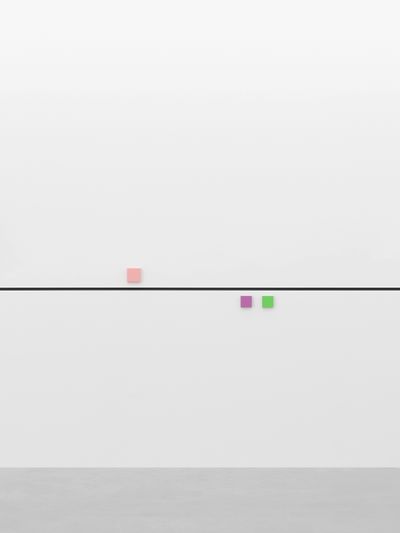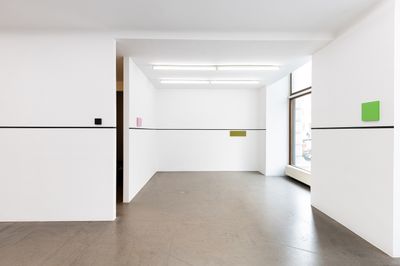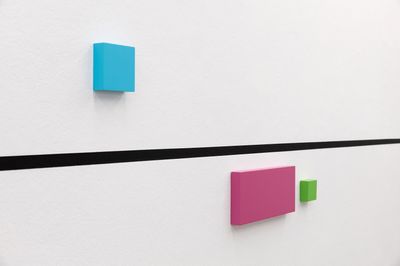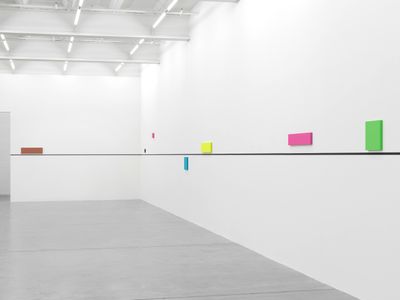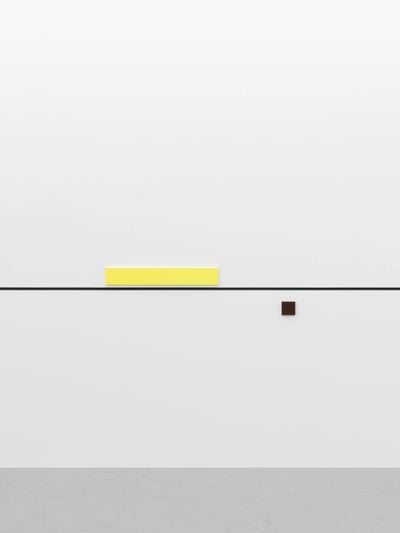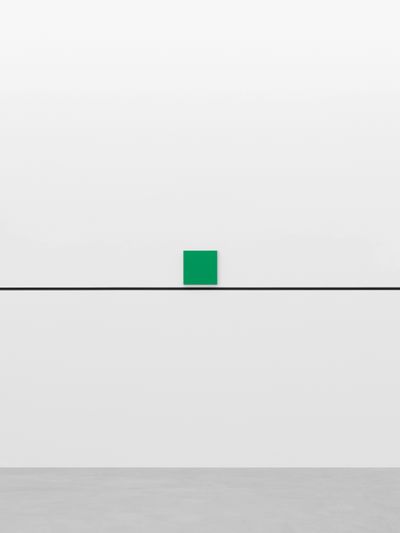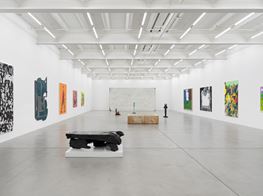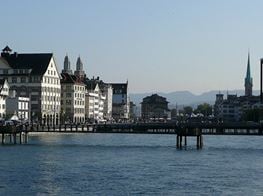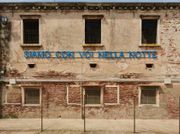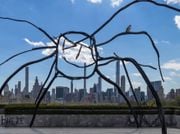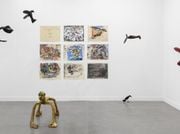Gerwald Rockenschaub on Musicality and Funky Minimal
SPONSORED | GALERIE EVA PRESENHUBER
Exhibition view: Gerwald Rockenschaub, bass+ (re)modification, Galerie Eva Presenhuber, Zurich, MaagAreal (16 March–18 May 2024). © Gerwald Rockenschaub. Courtesy the artist and Galerie Eva Presenhuber, Zurich / Vienna. Photo: Stefan Altenburger Photography.
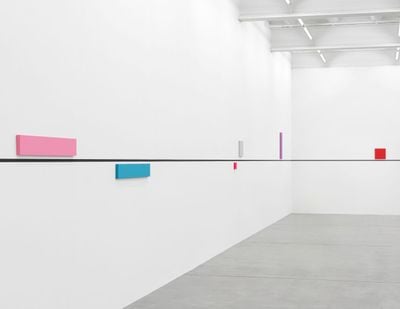
Exhibition view: Gerwald Rockenschaub, bass+ (re)modification, Galerie Eva Presenhuber, Zurich, MaagAreal (16 March–18 May 2024). © Gerwald Rockenschaub. Courtesy the artist and Galerie Eva Presenhuber, Zurich / Vienna. Photo: Stefan Altenburger Photography.
Austrian artist Gerwald Rockenschaub's current solo exhibition at Galerie Eva Presenhuber in Zurich distils what has made his work so notable over the years: an elegant precision pitched somewhere between restraint and playfulness.
In bass+ (re)modification, lacquered, rectangular, and monochrome MDF panels of various colours and sizes are positioned on either side of a black line running horizontally along the gallery walls. The objects use the pristine white walls as a support, expanding and transforming the room as it concertinas back and forth between a three-dimensional composition and a flat drawing.
For Rockenschaub, even language is a medium onto which he can train his exacting eye. Many of his works are economically titled, using a few words including allusions to music and punctuation marks. The works in this exhibition, for example, are titled bass+ (re)modification. Rockenschaub also liberally employs punctuation marks in writing, such as the forward slash that is peppered throughout this conversation.
Certain materials have recurred throughout his work since the artist began experimenting with the visual language of abstraction in the early 1980s, among them intarsia wool, acrylic, foil, industrially produced Plexiglas, and PVC (often in the form of large inflatables). In the following decades, Rockenschaub harnessed the power of modern technologies by incorporating computer-generated graphics and animations into his exhibitions.
Rockenschaub's installations begin as virtual drawings before they are translated to a three-dimensional model, in which the artist orchestrates the interaction of architectural space with his chosen shapes, colours, and lines. These elements are made to play off one another, creating different rhythms akin to the music Rockenschaub has been composing and mixing since the 1990s as an electronic music DJ.
The artist refers to what he creates in both art and music as a 'dramaturgy'. The term describes how he composes parts in relation to one another and in relation to the whole in a way that locates us in the realm of performance. I'm immediately reminded of Michael Fried's now-classic diatribe 'Art and Objecthood', in which the author rails against theatricality. Fortunately for Rockenschaub, American Minimalism—with its overbearing dogma and too-often self-serious adherents—has never been so great a preoccupation as to limit him. Instead, he continues to pursue his own interests, remixing parts of various art-historical sources from the Bauhaus to Pop art in order to create his idiosyncratic style of 'funky minimal'.
In the following conversation, the artist details the works in bass+ (re)modification, key elements of his signature style, and the relationship music has to his installations.
TJMCentral to your latest exhibition is a black horizontal line that nearly runs the entire perimeter of the gallery. It's like a horizon line or the Equator, dramatically separating what sits on either side of it. Above and beneath this line, coloured quadrilaterals of different sizes float as if held there by the line's gravitational force. You explored something similar in your show Quantum Fluctuation Modification at Galerie Krobath in 2023 . What's the relationship between these two exhibitions?
GRWhen I was collecting ideas for the show at Krobath, one concept was highly attractive to me: simply put, how I can make as much as possible of very little, and without massive production and transportation costs, but very effectively. Which concept is suitable for small and large venues and can also easily and flexibly be adapted to many different spaces? Which concept also represents best my idea of musicality and 'funky minimal'? I introduced the black horizontal line to visualise / display the size / volume of the exhibition space and to allow me to playfully place the different objects.
TJMThe current exhibition's title bass+ (re)modification seems to refer to music and a process of (material or formal) transformation. How did the ideas for this exhibition develop?
GRThe title bass+ (re)modification can also be seen as the title of the potential soundtrack of the show or the musical guide for the installation. Here (re)modification refers to the show at Galerie Krobath in Vienna last year. I modified and adapted / customised the idea of that show to match the architectural requirements of Galerie Eva Presenhuber's venue.
Many titles I generate for my shows / installations refer to music in some way. Punctuation and the setting of special symbols are very important to me, when I construct a title. For example: bass+ (re)modification implies something very different to bass + (re)modification. In other cases my titles serve as catchphrases and / or define the coding of the installation. See: Funky Minimal, Simple Philosophy, Geometric Playground.
TJMIs there any governing principle that determines which form and what medium you end up using—sculpture, painting, or digital animation—or do your ideas move freely across these?
GRI compose and orchestrate each exhibition for the actual venue. I check out the characteristics of the architecture and then develop a concept, which, I think, works best. Regarding exhibitions I always think in interrelations. For me, individual works have a specific function in an actual exhibition design / exhibition layout and are fabricated specifically for that purpose.
TJMYou've often worked with computer drawings to design your exhibitions, later working in situ to play with the forms and colours to respond to the space. Did you adopt a similar working process for this show and how long did it take you to install?
GRI work with specialised design and architecture software. For this show I made 2D sketches in a programme called Illustrator, tried out different set-ups of the objects, then constructed a virtual 3D model in Vectorworks, in which I can virtually walk around and validate the function value of my design. This allows me to playfully define the ultimate set up of the different objects more precisely in situ and give the whole installation the final funky touch.
For this exhibition in Zurich, I prepared a lot in advance, so it would not take me a lot of time to install the show. It took us—two very qualified assistants and me—around seven to eight hours to install everything. The black line was painted before I arrived.
TJMIt may come as a surprise to some that the forms in your latest exhibition are made of medium density fibreboard (MDF). Their lacquered finish gives the impression of a completely different material. What did the process of having these sculptures fabricated involve and how precisely did you determine the colours, finishes, and sizes beforehand?
GRIn general it's very easy to control the final outcome of the objects by the production of prototypes beforehand. I precisely defined the sizes, finishes, and colours before having them produced by a specialised firm.
TJMThere's often a sense of playfulness in your work, like Minimalism gone rogue or, to use your own words, a funky kind of minimalism. How much of your practice has involved having to consciously push against the art historical weight of American Minimalism, which is notoriously self-serious, macho, and dogmatic?
GRI never really felt the weight of Minimalism beyond art-historical interest, it never ever occupied my mind.
TJMI noticed you use the word 'dramaturgy' to describe a function of your exhibitions, which brings us squarely into this territory of theatre and performance. How much do other disciplines like theatre, performance, design, and music influence your art making?
GRAs a result of also composing music, which I occasionally publish on SoundCloud, I naturally take a similar approach to creating an object or exhibition concept as I do to composing a piece of music. In the 90s I was DJing a lot and also hosted a club in Vienna for a number of years. When DJing, dramaturgy is essential to your performance—which track do you play first, which track follows next, when do you use certain dramatic effects, when do you slow down a bit or increase / boost the dynamic, etc.
When I create a concept for a show, I think very musically. Choreography, dramaturgy, and rhythm always play a role—which objects go in which order / sequence, at which height, at what distance from each other, etc. When there is a series of different rooms to decorate / equip with objects, sculptures or a specific wall design, it's the same—what goes into the first room, what happens in the second, and so on, how do I design a varying and interesting sequence / parcour.
TJMWhat is your relationship now to the designation of Neo-Geo and how your work has been seen and historicised within that movement?
GRIn the 80s I was part of this trend. Someone came up with the term Neo-Geo and then it was called that. Artists who did similar things or had a similar idea of art, who nevertheless expressed themselves in very different ways, were then brought together under one term or trend.
TJMYours is an art of reduction, of paring back. You once said that if you lived in Baroque or Rococo architecture you'd find a way to push it aside in order to live and work. What in the contemporary world do you have to push aside as excess—media, the work of other artists—to make your art? What conditions are most conducive for you to create, what inspires and what distracts?
GRBasically I find so many things highly interesting and attractive, so I do not really try to push anything aside in the first place, but then I also decide very quickly, what is really appealing / worthwhile to me in the end and eliminate what I identify as bullshit.When I work, develop a piece of art, an exhibition or compose my music, I'm always very focused anyway and cannot be distracted so easily. —[O]

